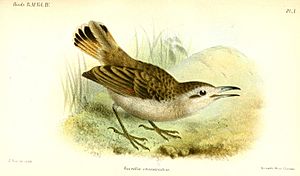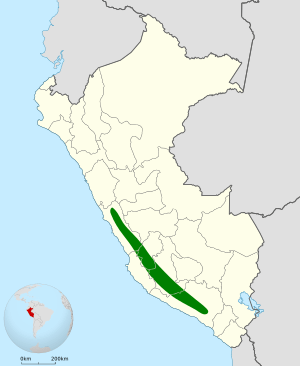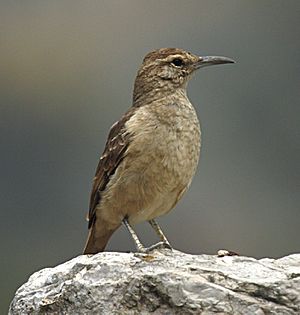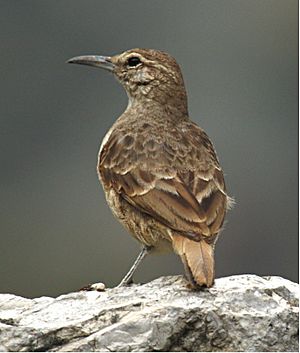Thick-billed miner facts for kids
Quick facts for kids Thick-billed miner |
|
|---|---|
 |
|
| Conservation status | |
| Scientific classification | |
| Genus: |
Geositta
|
| Species: |
crassirostris
|
 |
|
The thick-billed miner (Geositta crassirostris) is a type of bird. It belongs to a group of birds called "miners" and "leaftossers." These birds are part of the ovenbird family called Furnariidae. This special bird lives only in Peru.
Contents
How Scientists Classify the Thick-billed Miner
Scientists have different ideas about how to group the thick-billed miner. This is called its taxonomy.
Some groups, like the International Ornithological Committee, say there are two types, or "subspecies," of the thick-billed miner:
- The main type, called G. c. crassirostris.
- Another type, called G. c. fortis.
However, other groups, like the Clements taxonomy, think there is only one type. They do not recognize G. c. fortis.
The thick-billed miner is also a "sister species" to the campo miner. This means they are very closely related.
What Does the Thick-billed Miner Look Like?
The thick-billed miner is a fairly large bird for its group. It is about 18.5 to 19 centimeters (7.3 to 7.5 inches) long. It weighs between 42 and 55 grams (1.5 to 1.9 ounces). Both male and female birds look the same.
The main type of thick-billed miner has a pale face. It has a creamy stripe above its eye, called a supercilium. Its body from its head to its back is brown or gray-brown. Its tail feathers are mostly reddish-brown with dark tips.
Its wing feathers are brown or gray-brown. The main flight feathers are dark with lots of reddish-brown. The other flight feathers are reddish-brown with a dark bar near the end.
Its chin is white. Its chest and belly are a pale grayish-buff color. Its eyes are brown. It has a strong, curved bill. The top part of the bill is blackish-gray, and the bottom part is blue-gray. Its legs and feet are whitish to grayish.
The G. c. fortis subspecies has more reddish colors on its upper body. It also has more reddish-brown on its flight feathers.
Where the Thick-billed Miner Lives
We don't know the exact area where the thick-billed miner lives. Generally, it lives on the coastal hills and the western side of the Andes mountains in Peru. It can be found from central to southwestern Peru.
The main subspecies lives more to the north. It likes dry, rocky slopes with scattered bushes and tall, thin cacti. Near the coast, it lives at heights between 300 and 800 meters (980 and 2,600 feet). In the Andes, it lives much higher, between 1,875 and 3,550 meters (6,152 and 11,647 feet).
How the Thick-billed Miner Behaves
Movement and Daily Life
The thick-billed miner seems to live in the same area all year round. It does not migrate.
What the Thick-billed Miner Eats
This bird finds its food on the ground. It usually searches alone or in pairs. It walks and runs, then probes its bill into the ground or picks up food. Scientists haven't fully described its diet. However, they have found insect parts, plant material, and small bits of grit in their stomachs.
Life Cycle and Reproduction
Scientists do not know much about how the thick-billed miner breeds. It is thought that, like other birds in its group, it probably builds its nest in a burrow in the ground.
Sounds and Calls
The thick-billed miner has a strong song. It starts with quick "cueew" notes that get faster. Then it often turns into a harsh, grating sound like "djeer-djeer-djeer-djeer..." Its call is a rising and falling "reew" sound, like a soft meow.
Is the Thick-billed Miner Endangered?
The IUCN (International Union for Conservation of Nature) has looked at the thick-billed miner. They have listed it as a species of "Least Concern." This means it is not currently in danger of disappearing.
It lives in a large area. However, we don't know how many thick-billed miners there are. Scientists believe their numbers might be going down. No immediate threats have been found. It is considered "uncommon to locally fairly common." Human activities probably do not affect it much.
See also
 In Spanish: Minero picogrueso para niños
In Spanish: Minero picogrueso para niños




